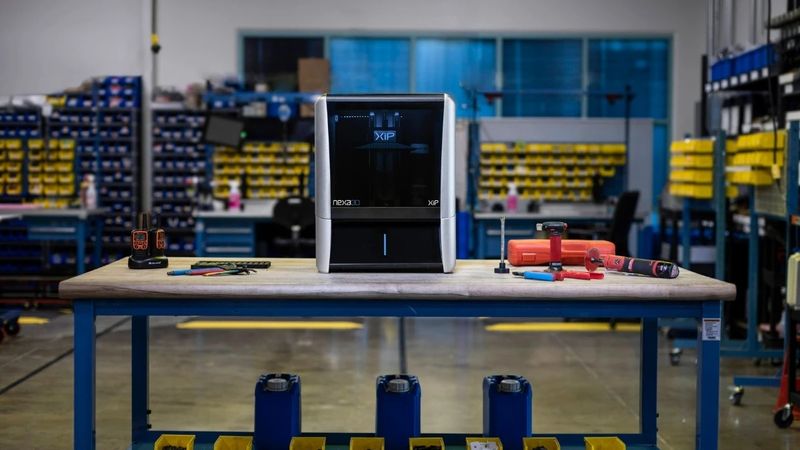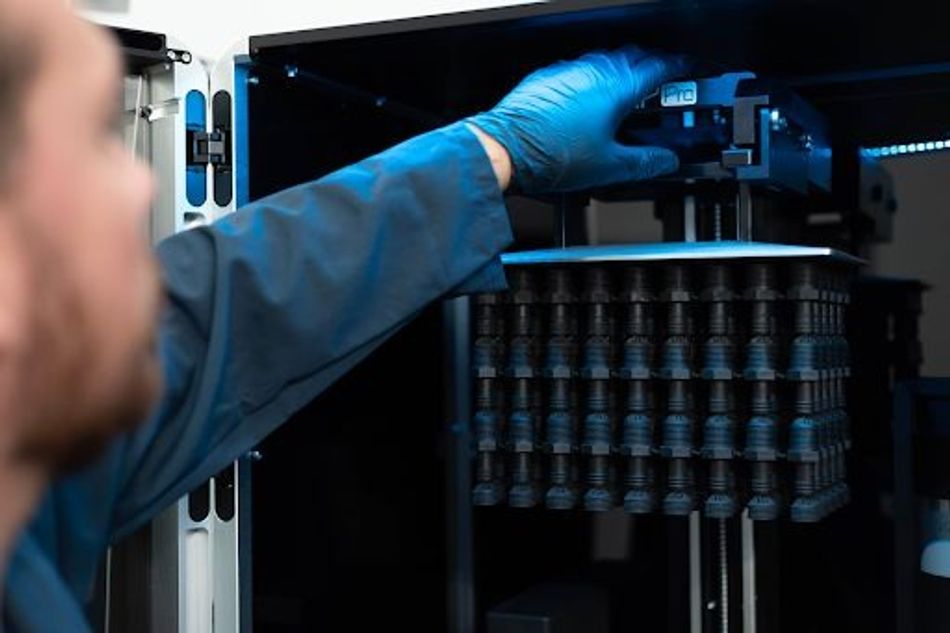Reducing the carbon footprint of additive manufacturing
Reducing the carbon footprint of 3D printing requires work from 3D printer manufacturers and end-users. Nexa3D’s resin printers are built using recyclable materials and allow users to print responsibly too.

Credit: Nexa3D
Additive manufacturing is one of the greenest manufacturing technologies. 3D printers use minimal power, produce limited waste because they are additive rather than subtractive, and enable local production, minimizing the carbon footprint of shipping and logistics.
That being said, additive manufacturing has environmental challenges to address. While the process does not create waste material like chips, it does create waste in other ways. Failed prints, broken printer components, and surplus resin or powder may all end up in a landfill. Furthermore, manufacturing 3D printers and subsequently operating them causes emissions. Extrusion-style printers in particular release significant levels of volatile organic compounds (VOCs) and particulate matter (PM). Resin 3D printers are not immune to environmental criticism either. Although photopolymerization technologies like stereolithography (SLA) produce fewer emissions than extrusion technologies, they use thermosets that are not typically made from recycled materials or able to be recycled.
This article discusses how both manufacturers and end-users can reduce the carbon footprint of additive manufacturing. In particular, it looks at how Nexa3D’s resin 3D printers are addressing key environmental challenges head-on, reducing carbon emissions at three stages: during printer production, during printing, and even beyond the service life of the printer.
Environmental challenges faced by 3D printer hardware manufacturers
Makers of additive manufacturing hardware have a responsibility to minimize their carbon footprint. It’s easy for 3D printing companies to say their technologies are greener than CNC machining (in terms of waste) or injection molding (in terms of tooling logistics). But what about all the ways that additive manufacturing does create carbon emissions? The environmental impact of additive manufacturing can be divided into several areas, including energy consumption, product life cycle, waste materials, water footprint, impact on global warming, and air pollution.
Production
One of the first concerns for 3D printer companies is the production of their machines. Components are often produced by third party-manufacturers, creating emissions through manufacturing and shipping. While such emissions can be reduced by localizing the supply chain, it is often cheaper to use suppliers in places like China. Furthermore, companies must consider the kind of materials being used for these components. How are the raw materials processed? Can they be recycled after the printer’s service life?
Quality
The design and quality of the 3D printer is also tied to its carbon footprint. Quality engineering can result in an energy-efficient system that minimizes the energy consumption of each print cycle. Additionally, a well-built machine will typically result in fewer failed builds, which means fewer overall printing cycles and less scrap. Perhaps most importantly, a high-quality machine will have a longer product life cycle. If an end-user needs to replace their machine every few years, they are creating scrap as well as unnecessary production and supply chain emissions for the new machines.
Secondary processes
Another challenge for 3D printer hardware companies is the application of secondary processes and their respective contributions to the overall carbon footprint. The nature of these secondary processes is largely dependent on the 3D printing technology. For example, resin 3D prints need to be washed and cured, while laser sintering systems may use a separate powder handling machine that consumes additional energy.
Reducing the carbon footprint of additive manufacturing during printing
3D printer end-users can reduce the carbon footprint of additive manufacturing in various ways, starting with the purchase of the technology. For instance, end-users can research the power usage of different 3D printers and choose one with minimal energy consumption. They can also look for certain green certifications. For example, the UL GREENGUARD certification indicates a low-emission product, though it is only applicable to consumer-level extrusion printers.
Feedstock is another important factor for environmentally conscious printer users, with some materials having a greater carbon footprint than others. Development of recycled, bio-based, recyclable, and biodegradable materials is an ongoing area of research, particularly in extrusion 3D printing but also in vat photopolymerization. End-users can also choose to buy feedstock and other consumables locally. However, this can be difficult with 3D printers that use a closed materials platform. Some leading SLA printers, for example, are only compatible with the manufacturer’s proprietary resins.
Taking a systematic approach to printing can also reduce the carbon footprint of additive manufacturing. For instance, packing the build area with multiple models — perhaps using a nesting feature in the slicing software — allows for fewer total print cycles and less energy consumption. Other simple strategies can include using draft settings for prototypes to reduce machine operation time.
How Nexa3D’s resin printers minimize carbon emissions
Nexa3D is one 3D printer company taking a proactive approach to reducing the carbon footprint of additive manufacturing. Its resin 3D printers like the XiP and XiP Pro are not only built from recyclable materials, they also allow for energy-efficient printing and practical maintenance that contributes to a longer product life cycle.
Key to the sustainability of Nexa3D printers is their aluminum body and a two-part vat that can be reused over and over without needing replacement. Since both the XiP and XiP Pro are constructed from billet aluminum, parts of the printer body can be recycled at the end of the machine’s life cycle. Fortunately, Nexa3D has taken steps to ensure that life cycle is as long as possible: rather than using a planned obsolescence strategy and forcing users to periodically replace their machines with new models, the company allows users to update their printer with replacement components — a practice that is both ethical and sustainable.
Nexa3D resin printers can also reduce the carbon footprint of additive manufacturing during operation. The energy-efficient XiP directs almost all of its power usage (86%) to the light engine, with the rest powering the printer’s electronics. The XiP Pro, meanwhile, allows users to pack the build area with multiple parts thanks to its extra-large envelope (292 x 163 mm). Since the mSLA technology cures the whole XY plane at once, it becomes possible to print a whole vat full of parts without significantly increasing printing time or energy consumption.
Finally, all Nexa3D resin printers are built on an open materials platform. While the company sells a number of pre-qualified resins, it also allows users to source their own materials, allowing them to buy resin and consumables locally to minimize the carbon footprint of their additive manufacturing activities.
Sustainable printing
Nexa3D is one of a handful of 3D printer companies taking its carbon footprint seriously, and its commitment to sustainability over profit is evident through its modular systems and open materials platform.

